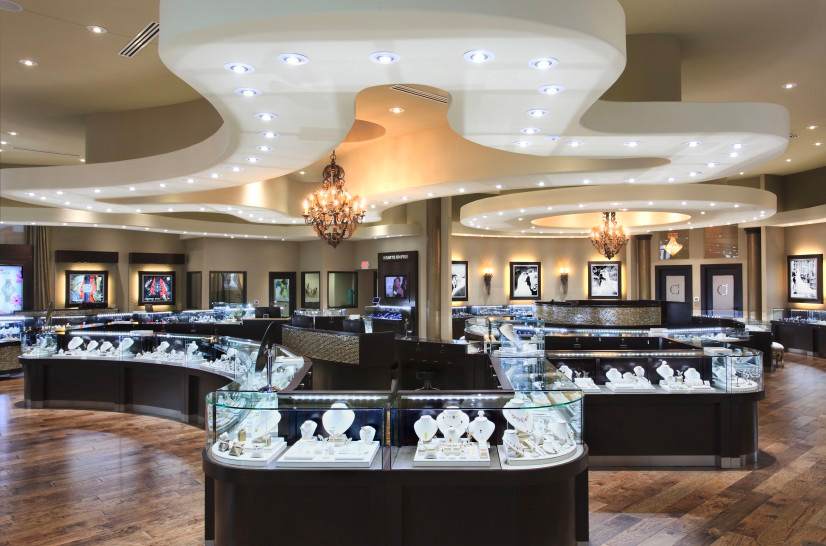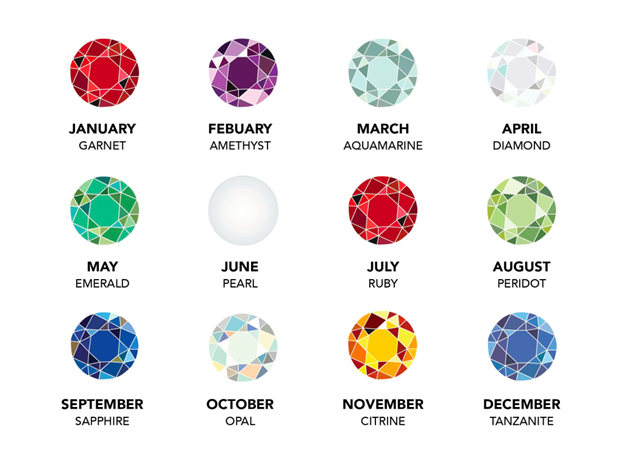
The Thirteen Best Jewelry Stores in Houston
October 12, 2022
A Guide to Different Types of Diamonds
December 17, 2022Birthstone Guide and Chart

You may have asked yourself at one point, “What’s my birthstone?” We’ve all been there, because many of us want to purchase jewelry for ourselves that represents, well, us. On the other hand, you might be asking the question “What’s the birthstone of my partner?” or even about a family member.
Birthstones are precious gemstones that represent the time of year when someone was born. Each month has a specific one. For example, January is garnet, and September is sapphire. Birthstones have an interesting history, and can be traced by to mentions that exist in the Book of Exodus, where precious stones represented the twelve tribes of Israel. However, modern uses of birthstones have only a small connection to early religious uses.
The modern story of birthstone use is a little less exciting. In 1912, the Jewelers of America met to standardize birthstones, and adopted a list. That list has changed over time, meaning that if someone was born prior to 1952, for example, their original birthstone might be different to what they’re ascribed now. Additionally, birthstones aren’t standardized across countries. For example, in the United Kingdom, the National Association of Goldsmiths has their own birthstone list, in operation since 1937. However, as time has gone by, the UK and the US’ birthstones have gotten more and more similar.
- January – Garnet
- February – Amethyst
- March – Aquamarine
- April – Diamond
- May – Emerald
- June – Pearl
- July – Ruby
- August – Peridot
- September – Sapphire
- October – Opal
- November – Topaz
- December – Tanzanite
- The Birthstone History Chart
January – Garnet
Garnets are a very well-known gem, enjoyed for their striking deep-red colour. The word ‘garnet’ comes from the 14th-century Middle English word ‘gernet’, meaning ‘dark red’. This word itself was derived from the Latin granatum, meaning seed. It is believed that they used this word due to the garnet’s resemblance to pomegranate seeds.

While garnets are known for being red, they actually come in a variety of colors, depending on their chemical makeup. Red garnets are pyrope garnets, whereas green garnets are known as tsavorites.
For many, the red garnets symbolize courage, faith, and a love.
February – Amethyst
The name amethyst comes from the Ancient Greek ‘methustos’, which actually means ‘intoxicated’. Ancient greeks believed that when wearing the stone, they would be protected from drunkenness.

The color of amethyst, while usually purple, ranges from light violet with a pinkish hue to very deep purple. Additionally, a stone isn’t necessarily the same color throughout, as deeper cuts reveal varying color layers.
These stones are made from quartz, and even though amethysts are rare, quartz is the second-most abundant material found within the Earth’s crust. It is said to represent royalty, hope, and passion.
March – Aquamarine
Aquamarine was traditionally believed to protect seafaring people such as sailors and fishermen. Now it has come to be known as a gem that represents creativity, courage, and self expression.

Color-wise, it ranges from greenish blue to deeper blue, which are the more valuable types of aquamarine. It is made from a variety of mineral called beryl, which is also where emeralds are derived from. The aquamarine crystals are some of the biggest to be found, with some found that are up to a foot in length.
April – Diamond
Diamonds are the most loved and most famous of all precious gemstones. They are made from pure carbon, pressurised into diamond through thousands to millions of years of external force and heat being exerted upon them. Because of this, they are 58 times harder than anything found in nature. Their beauty, quality, and rarity has made them a must-have jewelry item, and they are synonymous with matrimony and engagements.

The pure the diamond, the more colorless it is, and the higher the cut quality, the higher the price. They can be some of the most expensive gemstones on the market. Diamonds also come in what are known as ‘fancy colours’ where they contain hues that you wouldn’t necessarily expect, such as yellow or blue.
For many, they represent eternal love and courage.
Discover More About Diamonds
To start your diamond education journey, head to our diamond education section.I would also recommend reading some of my reviews, I suggest starting with Whiteflash, Brilliant Earth and James Allen.
May – Emerald
Enjoyed for their beautiful, rich green color, emeralds are loved for their representation of health and vitality. The deeper the green color, the more valuable it is, with some emeralds presenting a rare green-blue hue that is highly coveted amongst gem buyers. Like aquamarine, emeralds also come from the mineral beryl.

This kind of gemstone is found all over the world, with notable areas including Afghanistan, Zambia, and Brazil. However, finding truly high quality emeralds is difficult, and so emeralds are usually subjected to a lot of treatments that work to improve the quality and clarity of the gem before they go to market.
June – Pearl
Symbolising modesty and purity, pearls are one of the more unique ‘gemstones’ as they technically aren’t a gemstone at all, but a naturally occurring carbonate mineral that form spontaneously within mollusks when layers of calcium carbonate are deposited and grow over time.

The name pearl comes from the Old French ‘perle’, which in turn comes from the Latin perna, which means ‘leg’. This was used because an open mollusk shell has the shape of a leg of mutton (sheep). The most expensive pearls you will find are ‘natural’ pearls, or ones found in the wild and not produced in pearl farms. Today, majority of pearls come from artificially cultured stock.
These are the least durable of all gemstones due to their chemical makeup. Natural pearls will actually dissolve over time when placed in vinegar.
However, they’re still a highly-cherished form of gemstone, loved for their rarity and reflective luster.
July – Ruby
Ruby comes from the mineral corundum, and is given its red color by the presence of the element chromium. If chromium is not present, this gem will actually be classified as a sapphire.
The name comes from the Latin, rubeus, which simply means ‘red’. These stones used to be the most popular gemstone in ancient times, with the Sanskrit name for them being ‘ratnaraj’, or ‘king of previous stones’.

While rubies signify strength and courage, there is a certain irony to their existence, as the presence of chromium in these gemstones can weaken them, causing cracks and fissures. Due to this, only a small amount of rubies grow to sizes large enough to crystallize into high-quality, usable gems. Because of this, they often bring higher prices than diamonds.
August – Peridot
Peridots symbolise courage, wealth, wisdom and purity, but they also are believed to relieve stress during hard situations. However, others believe it is also associated with prosperity, as the name potentially comes from the Greek word ‘peridona’, which means ‘giving plenty’.

These gemstones are formed deep inside the Earth’s mantle and are made from olivine. However, in very rare circumstance peridot is also found inside meteorites that fall to Earth. The signature light green-yellow color comes from the chemical composition of olivine itself, which means they usually only come in one color.
This is in contrast to many other gemstones, whose colors come from chemical impurities found within the stone.
September – Sapphire
The word sapphire derives from similar words in Ancient Greek and Latin—sappheiros and sapphirus, which both mean ‘blue stone’. It is thought that these words originally used to refer to lapiz lazuli, a blue stone used to create blue paint. These gemstones come in every color except for red, which are classed as rubies.
There are also pink sapphires, which sit between the two gems, however there is usually a color saturation level that needs to be met for them to gain the ruby classification. The reason sapphires have such a wide variety of colors is that they often constrain trace elements such as titanium, iron, copper, or magnesium.
Sapphires represent truth and protection.
October – Opal
Around 95% of the world’s opal supply has been produced in Australia. Seasonal rains water the outback, which carries silica deposits deep underground into cracks in the bedrock. Upon the evaporation of the water, the silica deposits formed opal over time. Because of this, there have been instances where opal has formed around fossils, producing truly unique gemstone formations.

The name comes from the Greek opallios, which means ‘to see a change in color’, representing the kaleidoscopic color changes you can see in opal, which is the main part of its allure. For many, opal represents strength through adversity and sadness.
November – Topaz
With a name derived from the Greek topazios, topaz originally referred to any yellow gemstone. However, today the name is used specifically for the most yellow of gemstones found. They are said to represent success and prosperity.

Pure topaz itself is colorless, but many prefer to buy the yellow versions due to their interesting color and allure, especially when used in more vintage-style jewelry.
December – Tanzanite
Tanzanite is an incredibly rare jewel, as it is still only found in a few square miles of land in Tanzania. The mines in this area have a very low rate of production.
Chemically speaking, tanzanite is made from zoisite, but is the blue-purple variety. The blue-purple color coemes from trace amounts of vanadium that, when mixed with extreme heat upon formation, produce the color we all know and love. This ranges from pale blue to deep ultramarine.

Interestingly, tanzanite stones usually have pleochroism, which is an optical phenomenon where a substance has different colors when viewed from different angles. Because of this, the cut quality of tanzanite is emphasised upon production to get the most out of the stone.
The Birthstone History Chart
As you can see, birthstones and their relation to each month of the year has changed over time, with some being added and others being removed.
| Month | 15th–20th century | U.S. (1912) | UK (2013) | U.S. (2019) |
| January | garnet | garnet | garnet | garnet |
| February | amethyst, hyacinth, pearl | amethyst | amethyst | amethyst |
| March | bloodstone, jasper | bloodstone, aquamarine | aquamarine, bloodstone | aquamarine, bloodstone |
| April | diamond, sapphire | diamond | diamond, rock crystal | diamond |
| May | emerald, agate | emerald | emerald, chrysoprase | emerald |
| June | cat’s eye, turquoise, agate | pearl, moonstone | pearl, moonstone | pearl, moonstone, alexandrite |
| July | turquoise, onyx | ruby | ruby, carnelian | ruby |
| August | sardonyx, carnelian, moonstone, topaz | sardonyx, peridot | peridot, sardonyx | peridot, spinel |
| September | chrysolite | sapphire | sapphire, lapis lazuli | sapphire |
| October | opal, aquamarine | opal, tourmaline | opal | opal, tourmaline |
| November | topaz, pearl | topaz | topaz, citrine | topaz, citrine |
| December | bloodstone, ruby | turquoise, lapis lazuli | tanzanite, turquoise | turquoise, zircon, tanzanite |
Where to Find High-Quality Jewelry
So what are the recommendations? Of all the gemstone and jewelry retailers, these four are the ones I consistently return to:
Click each link to read my reviews of these fantastic jewelers and discover why they should be your first port of call when looking for the perfect piece for yourself or for a loved one.

